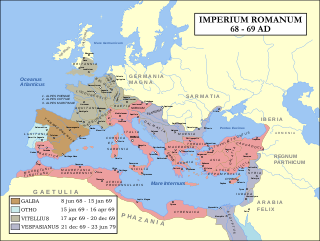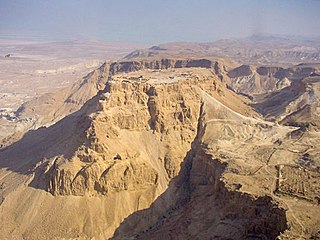
The 1st century was the century spanning AD 1 through AD 100 (C) according to the Julian calendar. It is often written as the 1st century AD or 1st century CE to distinguish it from the 1st century BC which preceded it. The 1st century is considered part of the Classical era, epoch, or historical period. The Roman Empire, Han China and the Parthian Persia were the most powerful and hegemonic states.

AD 69 (LXIX) was a common year starting on Sunday of the Julian calendar. In the Roman Empire, it was known as the Year of the consulship of Galba and Vinius. The denomination AD 69 for this year has been used since the early medieval period, when the Anno Domini calendar era became the prevalent method in Europe for naming years.

The 70s was a decade that ran from January 1, AD 70, to December 31, AD 79.

The 80s was a decade that ran from January 1, AD 80, to December 31, AD 89.

The 90s was a decade that ran from January 1, AD 90, to December 31, AD 99.
AD 25 (XXV) was a common year starting on Monday of the Julian calendar. At the time, it was known as the Year of the Consulship of Lentulus and Agrippa. The denomination AD 25 for this year has been used since the early medieval period, when the Anno Domini calendar era became the prevalent method in Europe for naming years.

AD 73 (LXXIII) was a common year starting on Friday of the Julian calendar. At the time, it was known as the Year of the Consulship of Domitian and Messalinus. The denomination AD 73 for this year has been used since the early medieval period, when the Anno Domini calendar era became the prevalent method in Europe for naming years.
AD 92 (XCII) was a leap year starting on Sunday of the Julian calendar. At the time, it was known as the Year of the Consulship of Augustus and Saturninus. The denomination AD 92 for this year has been used since the early medieval period, when the Anno Domini calendar era became the prevalent method in Europe for naming years.

The 130s was a decade that ran from January 1, 130, to December 31, 139.
The 140s decade ran from January 1, 140, to December 31, 149.
The 150s decade ran from January 1, 150, to December 31, 159.
Year 144 (CXLIV) was a leap year starting on Tuesday of the Julian calendar. At the time, it was known as the Year of the Consulship of Rufus and Maximus. The denomination 144 for this year has been used since the early medieval period, when the Anno Domini calendar era became the prevalent method in Europe for naming years.

Year 100 BC was a year of the pre-Julian Roman calendar. At the time it was known as the Year of the Consulship of Marius and Flaccus and the First Year of Tianhan. The denomination 100 BC for this year has been used since the early medieval period, when the Anno Domini calendar era became the prevalent method in Europe for naming years.
Year 177 (CLXXVII) was a common year starting on Tuesday of the Julian calendar. At the time, it was known as the Year of the Consulship of Commodus and Plautius. The denomination 177 for this year has been used since the early medieval period, when the Anno Domini calendar era became the prevalent method in Europe for naming years.

This article concerns the period 109 BC – 100 BC.
Lucius Antonius Saturninus was a Roman senator and general during the reign of Vespasian and his sons. While governor of the province called Germania Superior, motivated by a personal grudge against Emperor Domitian, he led a rebellion known as the Revolt of Saturninus, involving the legions Legio XIV Gemina and Legio XXI Rapax, camped in Moguntiacum (Mainz).
Polycarpus I of Byzantium was a bishop of Byzantium. He succeeded bishop Onesimus in 69 AD, and served in that office until his death in 89 AD. His last eight years of office were during Roman emperor Domitian's persecution of the Christians. His relics are deposited in the church of Argyropouli.
This article concerns the period 99 BC – 90 BC.
Titus Flavius Norbanus was a Roman equites who was active during the reign of Domitian. He is known for his activities while holding two imperial posts: governor of Raetia, and Praetorian prefect.







